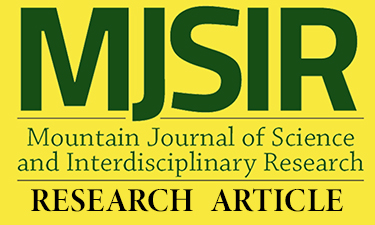Development of Organic Fertilizer Products and Systems to Improve Soil Fertility of Organic Vegetable Production of Cabbage in Benguet, Philippines
Main Article Content
Abstract
Formulation of organic fertilizers were studied to support organic vegetable production in Benguet, Philippines. The formulated liquid organic fertilizers based on farmers’ concoctions showed very low nutrient contents. New formulations using legume seeds were done which resulted to higher nutrient contents. Likewise, solid organic fertilizers were formulated using locally available raw materials. A combination of 50% chicken manure, 20% sawdust, 20% sunflower leaves, 10% Alnus compost and Trichoderma gave the highest nutrient contents. The solid and reformulated organic liquid fertilizers and Trichoderma were tested on cabbage grown in farm under conversion to organic production. Lower yields were observed during the early part of conversion. However, after three years of conversion, the yields of cabbage had significantly increased which were comparable to the yield in conventional farms. The recommended rates of solid and liquid formulated organic fertilizers found effective for both cabbage are 10t/ha of formulated solid fertilizer and 60 ml/L of liquid fertilizer, respectively. The nutrient management system found effective for organic production of cabbage was the application of Trichoderma two weeks before planting and split application of solid organic fertilizers three times during the growing period, that is, before planting, 15 days after planting and 30 days after planting at the rate of 2.5, 2.5 and 5.0 t/ha, respectively. The organic liquid fertilizer was applied at the rate of 60 ml per liter of water 15 days after planting and every two weeks thereafter until cabbage heads have formed. This nutrient management system provided the crops the essential nutrients during the critical growth and reproductive stages which resulted to higher yields comparable to those produced in conventional farms.
Article Details
References
Brady, N.C. & Weil, R.R. (2002). The nature and properties of soils. Upper Saddle River, New Jersey: Pearson Education, Inc., Prentice Hall. pp. 273, 375, 498, 519, 641, and 926. 2002.
Bureau of Agriculture and Fisheries Standards. (2013). Philippine National Standards for Organic Fertilizers.
Calubaquib, M.M., Navarrete, I.A. & Sanchez. P.B. (2016). Properties and Nutrient Status of Degraded Soils in Luzon, Philippines. Philippine Journal of Science 145 (3): 249-258
Clark, M.S., Horwath, W.R., Shennan, C., & Scow. K.M. (1998). Changes in Soil Chemical Properties Resulting from Organic and Low-Input Farming Practices. Agron. J. 90:662-671.
Datic, C.G.G., Laurean, C.P. & Nagpala, A.L. (2015). Soil Quality Assessment of Conventional and Organic Farms in La Trinidad, Benguet. BSU Research Journal.
Drinkwater, L.E., Letourneau, D.K., Workneh, F., van Bruggen, A.H.C., & Shennan, C. (1995). Fundamental difference between conventional and organic tomato agroecosystem in California. Ecol. Appl. 5: 1098-1112.
Eroa, M.J. (2015). Production and Characterization of Organic Fertilizer from Tubang-Bakod (Jatropha curcas) Seed Cake and Chicken. Asia Pacific Journal of Multidisciplinary Research 3(4): 9-13.
Jensen, H., Guilaran, L., Jaranilla R., & Garingalao, G. (2006). Organic amendments adopted and adapted by farmers in the Western Visayas Region of The Philippines: A handbook of preparations and techniques inspired by Nature Farming and adapted to locally available materials and needs. Pambansang Inisyatibo sa Binhi Likas-Kayang Pagsasaka sa Pilipinas (PABINHI-Pilipinas), National Initiative on Seed and Sustainable Agriculture in the Philippines, Batong Malake, Los Baños Laguna, The Philippines
Laurean, C.P. (1987). Formulation and Utilization of Organic Fertilizers. Unpublished MS Thesis. Benguet State University, La Trinidad, Benguet.
Laurean, C.P., Fagyan, A.W., & Dayap, E.P. (2015). Soil Fertility Status of Major Agricultural Areas in the Seven Municipalities of Benguet. BSU Research Journal.
Lu, J.L. (2009). Total Pesticide Exposure Calculation among Vegetable Farmers in Benguet, Philippines. Journal of Environmental and Public Health, 2009, 1–5. doi: 10.1155/2009/412054.
Melero, S., Porras, J.C., Herencia, R.J., & Madejon, F.E. (2006). Chemical and biochemical properties in a silty loam soil under conventional and organic management. Soil & Tillage Research 90:162–170
Mendoza, T. (2008). Nature Farming in the Philippines. Phibunwatthanawong T, N Riddech. 2019. Liquid organic production for growing vegetables under hydrophonic condition. International Journal of Recycling and Organic Waste in Agriculture
Roy, S., Arunachalam, K., Dutta, B.K., & Arunachalam, A. (2010). Effect of organic amendments of soil on growth and productivity of three common crops viz. Zea mays, Phaseolus vulgaris and Abelmoschus esculentus. Applied Soil Ecology 45: 78–84.
Sajib, K., Dash, P.K., Adhikary, B., & Mannan, M.A. (2015). Yield Performance of Cabbage under Different Combination of Manure and Fertilizers. World Journal of Agricultural Sciences 11 (6): 411422.
Schjonning, P., Elmont, S., & Cristensen. B.T. (2004). Managing Soil Quality: Challenge in Modern Agriculture. CAB International, United Kingdom. Pp. 104-106.
Tad-awan, B.A., & Shagol, C.C. (2016). Varietal Response of Cabbage to Drought Condition in La Trinidad, Benguet, Philippines. BSU Research Journal 76:45-52.
Tad-awan B.A., & Basquial, D.A. (2015). Growth and Yield Performance and Genotype x Environment Interaction of Cabbage Varieties under Organic Production in Benguet. BSU Research Journal 74: 35-49.
Taiz L, & Zeiger, E. (2002). Plant Physiology 3rd ed. Sunderland: Sinauer Associates. p 690.
Tan, K.H. (2003). Humic Matter in Soil and the Environment. Marcel Dekker, Inc. 270 Madison Ave. New York.
Teasdale, J.R., Coffman, C.B., & Mangum, R.W. (2007). Potential Long-Term Benefits of No-Tillage and Organic Cropping Systems for Grain Production and Soil Improvement. Agron. J. 99:1297–1305.
Tiessen, S.L., Cuevas, E. & Chacon, P. (1994). The role of soil organic matter in sustaining soil fertility. Nature (London) 371: 783-785.
Wander, M.M., Traina, S.J., Stinner, B.R., & Peters, S.E. (1994). Organic and conventional management effects on biological active organic matter pools. Soil Sci. Soc. Am. J. 58:1130-1139.
Werner, M.W. (1997). Soil quality characteristics during conversion to organic orchard management. Appl. Soil. Ecol. 5:151-167.

